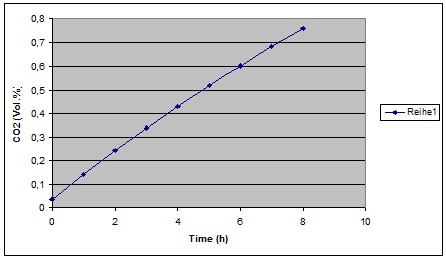Table of Contents
The ventilation system – there is no alternative
Author: Dr. Vajda József, University of Pécs, Hungary
Indoor air quality (IAQ)
Good indoor air quality (IAQ) is a top priority in any building – and, in addition to its small energy consumption, one of the Passive House’s many advantages. In Passive Houses, a healthy indoor climate is achieved in the following ways:
- by meeting the thermal comfort criteria, including the prevention of areas with local thermal discomfort (see also “Thermal Comfort in the Passive House”),
- through controlled home ventilation, which ensures an excellent indoor air quality.
This article shows that without controlled home ventilation, the concentration of CO2 in the indoor air quickly exceeds the limit value for good indoor air quality.
The following sample calculation is based on a bedroom (room volume 35 m³) that is occupied by 2 persons.
Other boundary conditions are as follows:
- The windows of the bedroom are always closed during sleeping times (to prevent drops in temperatures during the winter, traffic noise, insects, outside dust pollution etc.).
- The level of airtightness of the room meets the Passive House requirement (n50 < 0.6 1/h).
- The wind shield coefficient is e = 0.07 (moderate shielding), the volumetric fresh air flow through gaps is therefore:
$$ \Large{n_{2} = V_{Raum} \cdot n_{50} \cdot e = 1,47 \dfrac{m^{3}}{h}} $$
- The concentration of CO2 in the external air is 700 mg/m3, i.e. 360 ppm (according to CR 1752).
- The CO2 produced by the occupants of the room is 18 l/(h×person) (resting state, 1-1.2 met).
- The Pettenkofer value of 0.1 vol. % is considered as the limit value for good indoor air quality.
The calculations that were carried out show that in the present case, the Pettenkofer value would be exceeded within the first hour, and by the end of the sleeping period, the CO2 concentration would have reached 0.8 vol. % (see table and figure below).
Table: increase in the concentration of CO2 in the bedroom, plotted against time.
| Time (h) | 0 | 1 | 2 | 3 | 4 | 5 | 6 | 7 | 8 | |
| CO2 (vol.%) | 0.036 | 0.140 | 0.240 | 0.336 | 0.428 | 0.516 | 0.600 | 0.681 | 0.758 | |
Conclusion
Increasing the level of airtightness in a new construction or old building for reasons of energy conservation, e.g. by adding rubber sealing strips in the windows, will certainly lead to energy savings, but it will also increase the risk of poor or even unhealthy indoor air quality.
A ventilation unit with heat recovery is absolutely essential for meeting the requirements for a healthy indoor climate while allowing for significant energy savings; and once this requirement has been met, the most sensible and economical option will be to fulfil all the remaining Passive House criteria and build a Passive House.
